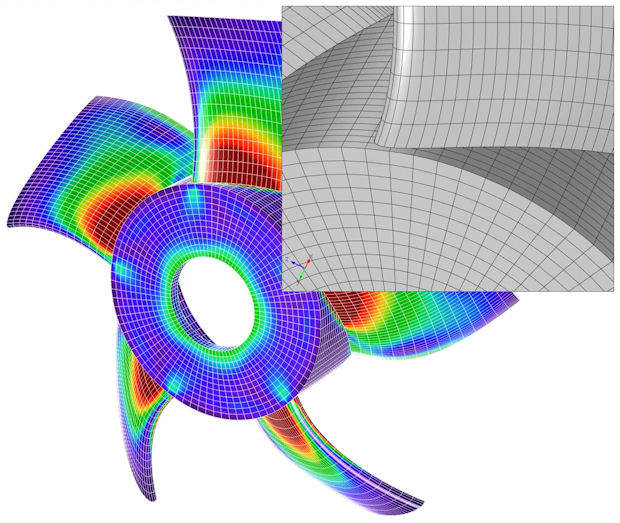Lots of Reasons to Check Out Multiphysics 5.0
Latest News
November 11, 2014
 Dear Desktop Engineering Reader:
Dear Desktop Engineering Reader:
Version 5.0 of the COMSOL Multiphysics suite of engineering and scientific simulation software has arrived. And anyway you look at it, 5.0 is a major release. Here are a bunch of reasons why you should check it out.
A new capability called Application Builder is the big news in 5.0. Application Builder empowers simulation mavens to transform any COMSOL Multiphysics model into an application they can share with other engineers in your outfit. It has a drag-and-drop form editor to design an application’s user interface and a methods editor for programming customized commands or introducing new features into the model. The resulting application contains only those parameters relevant to the specific design under study.
Application Builder means you can encapsulate specialized analysis knowledge and deliver it to stakeholders to leverage during their new product development and research processes. Application Builder should boost productivity and innovation by reducing the amount of time analysts spend away from their studies creating calculations for colleagues. And the engineers receiving the application will recoup the downtime spent waiting for the analyst to do work for them. Everybody and your process will just keep moving.
Currently, Application Builder runs on the Windows version of COMSOL Multiphysics. Its applications run on COMSOL Multiphysics and the soon-to-be-released COMSOL Server using either an installed or web-based client. Good stuff.
COMSOL Multiphysics 5.0 has much more going on. It sees improvements and updates throughout its 25 application-specific modules. Additionally, 5.0 debuts new add-ons: a Ray Optics module, a Design module and LiveLink for Autodesk’s Revit building information modeling (BIM) software.
The Ray Optics module is something different. It integrates multiphysics simulation into the modeling of geometrical optics. With it, you can analyze systems in which the electromagnetic wavelength is much smaller than the model’s smallest geometric detail. It can also compute the trajectory of rays in graded and ungraded media as well as model polychromatic, unpolarized and partially coherent light.
The Design module expands the COMSOL Multiphysics CAD toolset with loft, fillet, chamfer, mid-surface and thicken operations as well as CAD import/export and a geometry repair functionality. LiveLink for Autodesk Revit brings multiphysics simulations into the architectural design workflow by enabling users to synchronize a geometry between Revit and COMSOL.
The core Multiphysics module has 10 new pre-defined multiphysics couplings, including joule heating with thermal expansion, plasma heat source, acoustic-structure interaction and thermoelectric and piezoelectric effect. The Particle Tracing module has new accumulation of particles, erosion and etch features. The AC/DC, RF (radio frequency) and Wave Optics modules now have a frequency- and material-controlled auto mesh suggestion that offers one-click meshing of infinite elements and periodic conditions.
Updates for studies and solvers include improvements for CAD assembly simulation, support for extra dimensions and the ability to sweep over sets of materials. For geometry and mesh creation, you can now create geometry using an imported mesh and call geometry subsequences using a linked subsequence. You can also copy, paste, duplicate, drag and drop materials.
Today’s Check it Out link takes you to full details on COMSOL Multiphysics 5.0. And I mean full. The landing page starts with a brief introduction video. Underneath it are lists of 5.0’s new features. Above are tabs that go to complete release details and a dedicated section on the Application Builder.
Hit the “Release Details” tab first. You’ll see a set of gray and blue links. Blue links go to details on the new features in a given analysis area. The gray links organize topics by discipline, such as mechanical and fluid. Click one and additional blue links offer info on physics phenomena in that category. For example, hitting the gray “Fluid” link brings up the computational fluid dynamics (CFD) module among others.
COMSOL’s Multiphysics 5.0 introductory website is cleverly done. It has lots of screen shots, the occasional animated GIF and tons of information. It is not, however, half as clever as the 5.0 release of COMSOL Multiphysics appears to be. Hit today’s Check it Out link and see what you think.
Thanks, Pal. – Lockwood
Anthony J. Lockwood
Editor at Large, Desktop Engineering
Subscribe to our FREE magazine, FREE email newsletters or both!
Latest News
About the Author
Anthony J. Lockwood is Digital Engineering’s founding editor. He is now retired. Contact him via [email protected].
Follow DE






